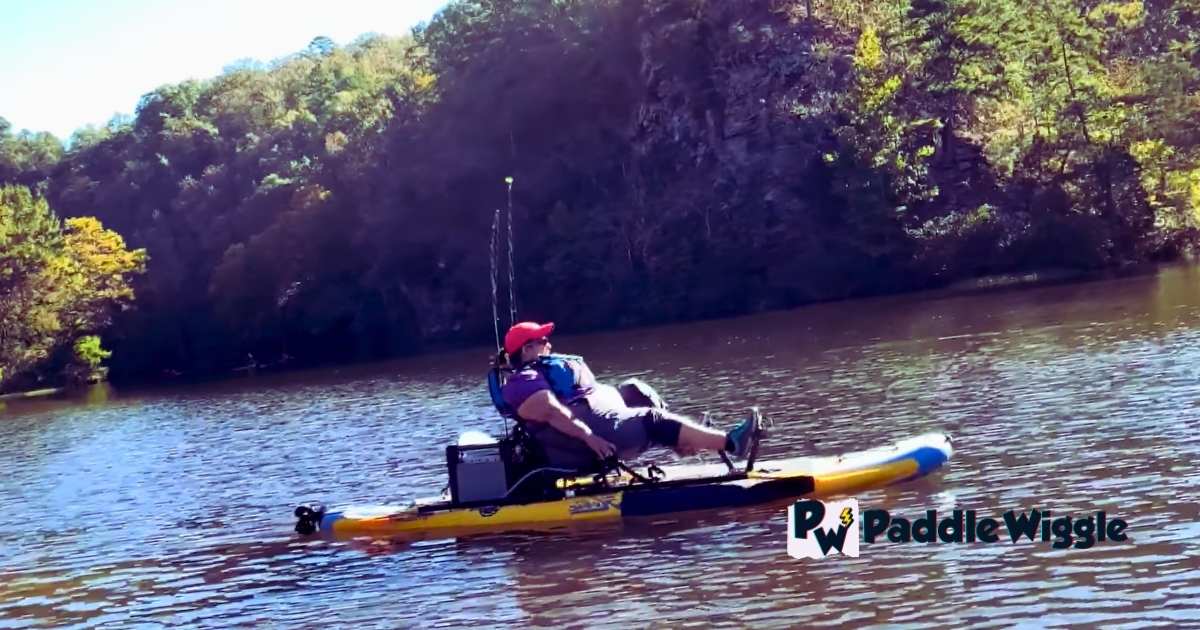If you’re overweight and considering kayaking, you might be wondering if kayaking is suitable for you. The good news is that kayaking can be accessible and enjoyable for people of all sizes and body types. Modern kayaks come in various designs, including those that offer greater stability and weight capacity.
Many kayaks are designed to support various weight ranges, ensuring stability and safety on the water. Beginners can start with wider, more stable kayaks to build confidence.
This guide includes a few kayaking facts for overweight individuals. Let’s get started!


Contents
Challenging Preconceptions About Kayaking And Body Size
Kayaking welcomes all body sizes, including larger individuals. Proper equipment and techniques make kayaking accessible and enjoyable for everyone. Embrace the adventure without body size limitations.
Kayaking is often seen as an activity reserved for the fit and athletic. This misconception can deter many from enjoying this fun and relaxing water sport. Let’s break down these barriers and explore the reality of kayaking for people of all body sizes.
Kayaking Is For Everyone
Kayaking is not exclusive to slim or athletic individuals. It’s an inclusive sport that welcomes everyone:
- Inclusive sport: Kayaking is designed for all, regardless of body size.
- Adaptive equipment: Many kayaks and gear are tailored for larger individuals.
- Community support: The kayaking community is known for its welcoming nature.
Myths About Body Size And Kayaking
Several myths perpetuate the idea that larger individuals can’t kayak. Let’s debunk these myths:
- Stability concerns: Modern kayaks offer stability for all body types.
- Physical strain: Paddling techniques reduce strain, making it accessible.
- Equipment limitations: Many manufacturers offer gear for various sizes.
Benefits Of Kayaking For All Body Sizes


Kayaking provides numerous benefits, promoting both physical and mental well-being. Some key advantages include:
- Low-impact exercise: Kayaking is gentle on joints, making it suitable for everyone.
- Stress relief: Being on the water offers a calming effect.
- Social activity: Kayaking can be enjoyed with friends and family.
Tips For Larger Individuals Kayaking
For those who are larger, here are some useful tips to enhance the kayaking experience:
- Choose the right kayak: Look for kayaks with higher weight capacities.
- Proper gear: Invest in a comfortable, well-fitting life jacket.
- Practice technique: Learn efficient paddling techniques to conserve energy.
Challenging these preconceptions about kayaking and body size opens up a world of adventure for everyone. Kayaking is not just a sport for the few but an enjoyable activity for all.
The Truth About Weight Capacities And Kayak Safety


Kayaking is accessible to everyone, regardless of size. Kayaks have weight capacities that ensure safety for heavier individuals. Choose the right kayak to enjoy the adventure safely.
Kayaking can be a fantastic outdoor activity for everyone, regardless of body type. Many wonder if weight affects their ability to kayak safely. The good news is that with the right information, everyone can enjoy this thrilling adventure. Let’s dive into the truth about weight capacities and kayak safety.
Understanding Weight Capacities
Different kayaks have varying weight capacities. It’s essential to choose one that suits your needs.
- Weight Capacity: Every kayak has a maximum weight limit, including the paddler and gear.
- Types of Kayaks: Recreational, touring, and fishing kayaks offer different capacities.
- Stability: Higher weight capacities often provide better stability in the water.
- Manufacturer Guidelines: Always check the manufacturer’s specifications to ensure safety.
Factors Affecting Kayak Safety
Several factors play a role in ensuring a safe kayaking experience. Here’s a closer look at these critical elements.
- Buoyancy: Ensures the kayak floats well, even with added weight.
- Durability: High-quality materials withstand heavier loads better.
- Seat Design: Comfortable and adjustable seats enhance stability and control.
- Balance: Proper weight distribution prevents tipping and enhances maneuverability.
Choosing The Right Kayak For Your Weight
Selecting the right kayak can make a world of difference. Here’s what to keep in mind.
Kayaks come in various shapes and sizes, each designed for different purposes. For heavier paddlers, wider and longer kayaks often provide better stability and comfort. Ensuring a snug fit with adjustable seats and footrests can enhance control and reduce fatigue.
Safety Tips For Heavier Paddlers
Safety should always be a priority. Follow these tips for a secure kayaking experience.
- Life Jackets: Always wear a properly fitted life jacket.
- Weather Conditions: Check weather forecasts and avoid rough waters.
- Buddy System: Kayak with a friend for added safety.
- Proper Gear: Use equipment designed for your weight and size.
Maintenance And Care For Kayaks
Regular maintenance ensures your kayak remains safe and functional. Here are some tips.
- Cleaning: Rinse your kayak with fresh water after each use.
- Storage: Store in a cool, dry place to prevent damage.
- Inspection: Regularly check for cracks or wear and tear.
- Repairs: Address any issues promptly to maintain safety.
Embracing the joy of kayaking is possible for everyone. With the right kayak and safety measures, you can confidently paddle away and explore the great outdoors.
Overcoming Self-doubt And Building Confidence in the Water
Kayaking is an inclusive activity suitable for all body types, including those with larger frames. Confidence in the water grows with practice and the right equipment. Embrace the adventure and enjoy the freedom kayaking offers.
Kayaking is a sport for everyone, regardless of size. Feeling hesitant about kayaking due to weight is common. However, it’s crucial to address self-doubt and build confidence to enjoy this rewarding activity.
Embracing Your Body’s Capabilities
Many people underestimate their own strengths and abilities. Embracing your body can transform your kayaking experience.
- Recognize your strengths: Focus on what you can do rather than limitations.
- Practice positive self-talk: Remind yourself of past achievements.
- Seek supportive communities: Join groups that encourage body positivity and inclusivity.
Setting Realistic Goals
Setting achievable goals helps build confidence. Start with small steps and gradually increase the challenge.
- Break tasks into smaller steps: Ease into kayaking with short trips.
- Celebrate small victories: Acknowledge each accomplishment to boost morale.
- Adjust goals as needed: Flexibility ensures steady progress.
Choosing The Right Equipment
Using suitable gear makes a big difference. The right equipment enhances comfort and performance on the water.
Choosing appropriate gear can greatly improve your kayaking experience. Here’s what to consider:
- Properly fitted kayak: Ensure the kayak supports your weight and size.
- Comfortable life jacket: Pick a life jacket designed for larger bodies.
- Quality paddles: Choose paddles that match your strength and height.
Seeking Professional Guidance
Professional advice can be invaluable. Experts can offer tailored advice and support.
- Take lessons from certified instructors: Learn techniques and safety practices.
- Ask for personalized tips: Instructors can provide insights based on your needs.
- Build a support network: Connect with experienced kayakers for ongoing encouragement.
Practicing Regularly
Regular practice boosts confidence. Consistency helps improve skills and reduce anxiety.
- Schedule frequent outings: Regular practice helps build familiarity.
- Track progress: Monitor improvements to stay motivated.
- Mix-up locations: Explore different waters for varied experiences.
Proper Technique And Safety Measures For Plus-size Kayakers
Plus-size individuals can absolutely enjoy kayaking by using the proper technique and adhering to safety measures. Choosing a stable kayak, wearing a well-fitted life jacket, and practicing good paddling form ensure a safe and enjoyable experience.
Kayaking is an exhilarating activity that knows no size limits. Plus-size individuals can enjoy the thrill of paddling just as much as anyone else. The key is to use proper techniques and follow essential safety measures. Here’s a guide to help plus-size kayakers make the most of their adventures on the water.
Selecting The Right Kayak
Choosing the appropriate kayak is crucial for a comfortable and safe experience.
- Weight Capacity: Ensure the kayak can support your weight, plus gear.
- Wider Cockpit: Provides better stability and easier entry/exit.
- Comfortable Seating: Look for adjustable seats with ample padding.
- Durability: Opt for kayaks made from robust materials.
Proper Paddling Technique
Mastering the right paddling techniques can enhance your kayaking experience.
- Grip: Hold the paddle with a relaxed grip, hands shoulder-width apart.
- Posture: Sit upright with your back straight to avoid strain.
- Stroke: Use a smooth, consistent stroke, engaging your core and arms.
- Breathing: Breathe steadily to maintain energy and rhythm.
Safety Measures To Follow
Staying safe on the water is paramount for any kayaker.
- Wear a PFD: Always wear a Personal Flotation Device (PFD) that fits well.
- Check Weather: Review the weather forecast before heading out.
- Buddy System: Kayak with a friend or group for added safety.
- Emergency Kit: Carry an emergency kit with essentials like a whistle, flashlight, and first-aid supplies.
Getting In And Out Of The Kayak
Proper technique can make entering and exiting the kayak easier and safer.
- Use a Dock: Position the kayak parallel to the dock for stability.
- Sit First: Sit on the edge of the seat, then swing your legs in.
- Balance: Keep your weight centered to avoid tipping.
- Exit Carefully: Reverse the process when getting out, using your arms for support.
Building Confidence On The Water
Confidence is key to enjoying your kayaking experience.
- Practice: Spend time practicing in calm, shallow waters.
- Take Lessons: Enroll in a kayaking class to learn from professionals.
- Start Slow: Begin with shorter trips and gradually increase distance.
- Positive Mindset: Stay positive and patient as you build your skills.
With the right techniques and safety measures, plus-size kayakers can fully enjoy the beauty and excitement of kayaking. Embrace the adventure and paddle on!
5 Tips To Make Kayaking Enjoyable For Overweight Individuals
Kayaking can be enjoyable for overweight individuals by choosing the right kayak, wearing a comfortable life jacket, and practicing proper techniques. Make sure to start with calm waters and gradually increase difficulty. Joining a supportive kayaking group can enhance the experience and boost confidence.
Kayaking is an exhilarating outdoor activity that anyone can enjoy, regardless of body size. Embracing the water and the freedom it offers can be a fantastic experience for overweight individuals. Here are some practical tips to make kayaking enjoyable and comfortable.
Choose The Right Kayak
Selecting the appropriate kayak is crucial for comfort and safety.
- Weight capacity: Ensure the kayak can support your weight.
- Stability: Opt for wider kayaks for better stability.
- Comfortable seating: Look for adjustable and padded seats.
Wear Proper Gear
Wearing the right gear enhances safety and comfort.
- Life jacket: Get a life jacket that fits well and supports your weight.
- Moisture-wicking clothing: Choose clothing that keeps you dry and comfortable.
- Footwear: Waterproof shoes or sandals with good grip.
Start With Calm Waters
Begin your kayaking journey on calm and gentle waters.
Calm waters, such as lakes or slow-moving rivers, are less intimidating and easier to navigate. They help build confidence and allow for a more relaxed experience.
Take Breaks And Hydrate
Regular breaks are essential for an enjoyable experience.
- Frequent breaks: Rest to avoid fatigue.
- Hydration: Bring plenty of water to stay hydrated.
- Snacks: Pack light and healthy snacks for energy.
Paddle With A Friend
Having a companion adds safety and fun to your adventure.
Kayaking with a friend provides support and encouragement. It also ensures you have help if needed, making the experience more enjoyable and less daunting.
Frequently Asked Questions
Can A 300 Pound Person Fit In A Kayak?
Yes, a 300-pound person can fit in a kayak. Choose a kayak with a weight capacity of at least 350 pounds.
Final Words
Kayaking is an inclusive activity for everyone, regardless of size. With the right gear and preparation, fat people can enjoy kayaking. With the right kayak and equipment, kayaking can be a rewarding activity that offers both physical exercise and relaxation.



